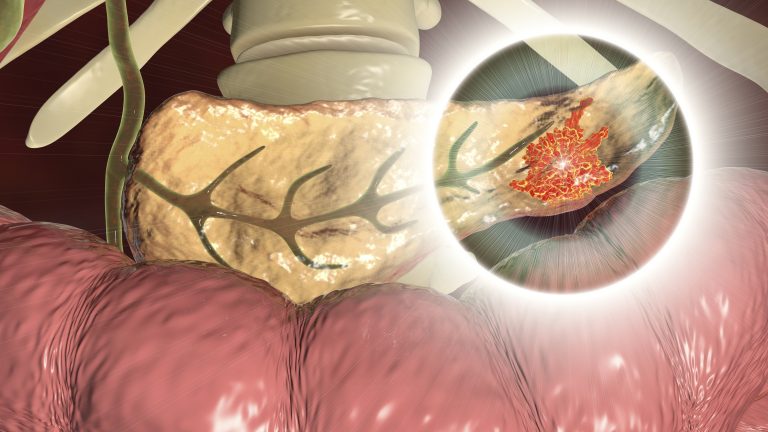
Studies in mouse models conducted by researchers at the Washington University School of Medicine, indicated that an investigational anti-inflammatory drug, ATI-450, may also reduce some of the damaging side effects of the chemotherapy cocktail FOLFIRINOX (a combination of folinic acid, 5-fluorouracil, irinotecan and oxaliplatin), which is commonly used to treat pancreatic cancer. ATI-450 is currently in clinical trials as a treatment for rheumatoid arthritis.
“There is a tremendous need for new and better therapies for pancreatic cancer,” said senior author and medical oncologist Kian-Huat Lim, M.D., Ph.D., an associate professor of medicine. “The drugs that we use now are powerful but often cause severe side effects, making it impossible to add more chemotherapy. This new drug appears to weaken the cancer cells and make them more sensitive to this particular chemotherapy regimen. In fact, the mice treated with chemotherapy plus this drug appear to be healthier than mice receiving chemotherapy alone, so there’s a chance the new drug is mitigating side effects.”
Lim, together with co-senior, and lead author, medical oncologist Patrick M. Grierson, M.D., Ph.D., an assistant professor of medicine, report on their findings in Science Translational Medicine, in a paper titled, “The MK2/Hsp27 axis is a major survival mechanism for pancreatic ductal adenocarcinoma under genotoxic stress.” Based on their data, Lim, Grierson and Aclaris Therapeutics, which provided ATI-450 for the study, have filed a patent application for methods of treating pancreatic cancer.
Pancreatic ductal adenocarcinoma (PDAC) is now the third leading cause of cancer-related death in the US and is projected to be the second by 2030, the authors wrote. “In 2021, 60,430 patients are predicted to be diagnosed with PDAC, and about 80% of them are predicted to succumb to the disease within 1 year of diagnosis, highlighting the urgent need to develop more effective therapeutic strategies.”
Pancreatic cancer is extremely difficult to treat. By the time it is detected, the cancer often has reached an advanced stage, and patients usually do not survive longer than one year after diagnosis. Currently, combination chemotherapies, including FOLFIRINOX represent the front-line treatment for pancreatic cancer and the only effective systemic treatments that meaningfully prolong the survival of patients with PDAC, the team continued. However, only about one in three patients will have tumor shrinkage following this therapy. And any response may only last six to seven months. Side effects are also common, and include nausea, vomiting, diarrhea, fatigue, hair loss, low blood counts and poor appetite.
The researchers set out to identify and characterize resistance mechanisms to a FIRINOX chemotherapy regimen (a combination of 5-fluorouracil, irinotecan and oxaliplatin). Using an unbiased reverse-phase protein array, the team detected phospho-activation of heat shock protein 27 (Hsp27) as the most up-regulated event after FIRINOX treatment in PDAC cells. Interestingly, silencing HSP27 using either RNA interference or a small-molecule inhibitor, enhanced apoptosis caused by FIRINOX in vitro.
Further studies identified a role for a molecule called MK2, in this signalling pathway, and demonstrated that MK2 was critical in allowing the pancreatic tumor cells to survive chemotherapy. “Mechanistically, FIRINOX up-regulated tumor necrosis factor–α (TNFα), causing autocrine phosphorylation and activation of transforming growth factor–β–activated kinase 1 (TAK1), MAPK activated protein kinase 2 (MAPKAPK2 or MK2), and, ultimately, Hsp27,” the authors explained. ATI-450 is an attractive drug to test against these cancer cells because it is an MK2 inhibitor.
“MK2 turns on pro-survival mechanisms that allow cancer cells to adapt to the severe stresses of chemotherapy,” said Grierson. “It also inhibits a type of cell death called apoptosis, thereby preventing tumor cells from dying in the face of chemo.” Lim and Grierson, who both treat pancreatic cancer patients at Siteman Cancer Center at Barnes-Jewish Hospital and Washington University School of Medicine, and their colleagues tested the drug’s effects in pancreatic cancer cell lines growing in the lab, and in vivo, in mice harboring human pancreatic cancer cells, and in a KPC mouse model that develops pancreatic cancer naturally because it is genetically prone to the disease.
Compared with chemotherapy alone, the combination of ATI-450 plus chemotherapy reduced tumor size by about half. Mice receiving the combination treatment also survived longer, living an average of 41 days after the start of treatment compared with an average of 28 days for the mice receiving chemotherapy alone. “As a single agent, ATI-450 delayed the progression of PDAC in KPC mice, a highly aggressive autochthonous PDAC mouse model,” the team noted. “Addition of ATI-450 to FIRINOX ablated the PDAC lesions in KPC mice, a result that we believe warrants advancing this regimen into the clinic … Targeting MK2 in combination with a FIRINOX-like regimen may be an effective and translatable therapeutic strategy for patients with PDAC.”
“This new drug inhibits MK2, so when the mice receive the drug at the same time that they receive chemotherapy, the tumor cells are much more susceptible to dying,” Grierson continued. “A nearly 50% increase in survival is a significant improvement. On top of that, it’s impressive that the drug did not worsen side effects. There is a concern with chemotherapy for pancreatic cancer that incorporation of additional drugs will make the treatment even less tolerable. We monitored blood counts and assessed toxicities on the small intestine and colon where we often see limiting toxicities, and the adverse effects were no worse with the combination treatment.”
Added Lim, “A lot of the side effects of chemotherapy are due to inflammation caused by molecules called cytokines. A benchmark for success in treating rheumatoid arthritis, which this drug was originally developed for, is the reduction of those cytokines. It’s possible we’re seeing the same effect in these mice.”
The researchers plan to continue investigating ATI-450 for pancreatic cancer, including whether this drug plus chemotherapy also can be combined with additional investigational treatments, such as immunotherapies. They suggested that the drug may also have the potential to improve treatment for other cancers, including colon and other gastrointestinal cancers, that are treated using similar chemotherapy regimens.













